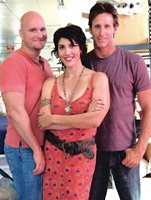Virtual Showrooms-Still Under Construction
Ever since American businesses embraced the Internet, there has been a steady stream of fashion entrepreneurs trying to build virtual fashion showrooms.
Currently, a handful of businesses is creating different versions of what an online showroom could be. Some distribute video lookbooks. Others offer e-commerce for wholesalers. Other technology companies offer online versions of showroom-management tasks, such as sales forecasting and inventory management.
Mary Helen Shashy, chief executive of production company OnlineFashionDistrict.com, said the videos and images of online showrooms are not intended to be a replacement for the real thing. They are meant to complement the feeling of touching a new line’s fabrics or seeing the new brand of jeans on a moving body. Consider it legwork for finding the right brands.
In May, Shashy started her production company, which produces video line sheets and photographed line sheets. With her crew of video camera people, photographers and Web designers, Shashy produces multimedia such as models displaying a showroom’s lines. Her Web site hosts the lookbooks or will integrate the videos into a label’s existing Web site.
The company’s basic package starts at $4,000 to capture 50 looks demonstrated per model. “We bring the [trade] show to the store,” she said. So far she has shot video lookbooks and photographed line sheets for labels Ed Hardy, Pink Lotus and Green Dragon.
Another virtual-showroom company is LA Showroom. It not only provides virtual showrooms for Los Angeles fashion labels such as Truelight and Misope, it offers an e-commerce market to sell the fashions where its members handle the sales.
Business is growing. This year the virtual showroom hired more than eight employees to work in its 7,500-square-foot offices and studios, located in the California Market Center. They photograph manufacturers’ garments as well as design and program the virtual market. Buyers and sellers must register to participate in LA Showroom’s marketplace of 250 showrooms, up from 200 in 2008.
The price of a virtual showroom is not cheap. It can cost between $10,000 and $200,000 to develop a management system for one company, said Aaron Levant, president of the Agenda trade show and Agenda showroom. For more than four years, he tried to create a virtual showroom for his Agenda showroom, but he scaled back his online efforts. “The buyers were not so gung ho about using it,” Levant said. Despite having line sheets and order forms available on the Web site, many buyers preferred salespeople faxing or mailing them business material.
Lee Decker understands that dilemma. In 2001, he started producing virtual showrooms, but his company changed course because entrepreneurs were wary of having their wholesale customers stolen by their competitors who might be exhibiting on the same virtual showroom.
Now Decker owns Hubsoft, a software producer in Laguna Beach, Calif., that focuses on the fashion industry. Since 2004, Hubsoft has offered management software that allows salespeople and showroom employees to perform various tasks, such as sales forecasting, order management and some direct-to-consumer sales online.
But like all things related to business, the cost of the technology is keeping a lot of manufacturers and showroom owners from stepping up to the Internet. “They don’t have a lot of money for management,” he said. “They have to be sure that it will work for them before they invest.”
Virtual vs. reality
Former players in the fashion tech game, such as Eugene Kim, wait and see who can build the kind of electronic fashion showroom every industry insider will want to own.
“Someone is going to get it right,” said Kim, who earlier this year closed down ThreadMe.com. It was his Los Angeles–based social-networking site, where designers and retailers met and virtually mulled over line sheets. “It’s just a matter of time,” he said.
Kim is now working in real estate. But he remembered thinking that in early 2008, when he startedThreadMe.com, fashion showroom owners would be crazy not to take advantage of the cost and time savings offered by the Internet.
“A salesperson can phone 30 retailers in one day if he or she is lucky,” Kim said. “But they can e-mail more than 20,000 people in less than one minute.”
Los Angeles showroom owner Liza Stewart joked that the fashion industry is often the last to embrace a technology, but she said there are good reasons why showroom owners have not moved into the virtual realm quite yet.
“What’s working is old school—that means using phones,” said Stewart, who owns Liza Stewart Inc. in the California Market Center. “There is nothing more immediate than speaking with a live person. It is part of building the relationship with the retailers.”
Stewart’s showroom takes orders by e-mail, fax and phone. But her clients, such as contemporary line Cynthia Steffe, provide virtual lookbooks on company Web sites.
Virtual lookbooks of established brands can be a big help for reordering, said Fred Levine, co-owner of M.Fredric, a chain of contemporary boutiques based in Agoura Hills, Calif. “I can avoid a trip to a showroom, which may or may not have those samples still showing,” he said.
The convenience of working online makes the idea of a virtual multiline showroom attractive, but seeing a photo might not be a good replacement for feeling and trying on a garment, Levine noted.























